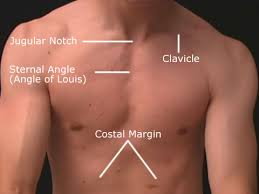 Sternal angle
Sternal angle
The sternal angle, also known as the angle of Louis.
It is the synarthrotic joint formed by the articulation of the manubrium and the body of the sternum.
It is a palpable clinical landmark in surface anatomy.
This is where the 2nd rib joins with the sternum.
It can be palpated easily.
The sternal angle marks the approximate level of the 2nd pair of costal cartilages, which attach to the second ribs, and the level of the intervertebral disc between T4 and T5.
The sternal angle can be palpated at the T4 vertebral level.
The sternal angle is the most popular reference point to use because it remains approximately 5 cm above right atrium regardless of the patient’s position.
It marks the start and end of the aortic arch, the division between the superior and inferior mediastinum, the lower margin of the superior vena cava, the crossing of the thoracic duct, the bifurcation of the trachea, the bifurcation of the pulmonary trunk, the drainage of the azygos vein into the superior vena cava, Thymus gland, in some cases, position of the deep cardiac plexus, junction of the intra and extra pericardial parts of the superior vena cava, line junction between C4 and T2 dermatome, articulation of 2nd costal cartilage on either side of the sternum, the carina of the trachea is deep to the sternal angle, passage of the thoracic duct from right to left behind esophagus, ligamentum arteriosum, and the loop of left recurrent laryngeal nerve around aortic arch.
The sternal angle is in the form of a secondary cartilaginous joint.
